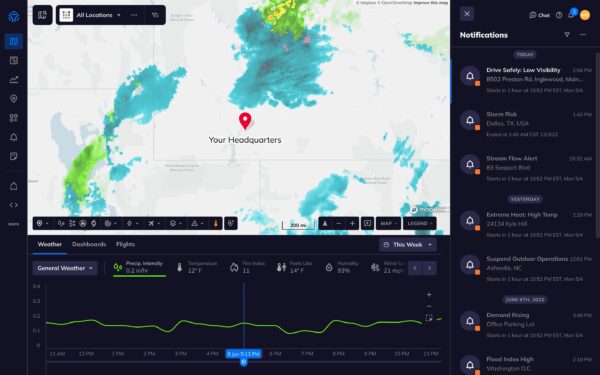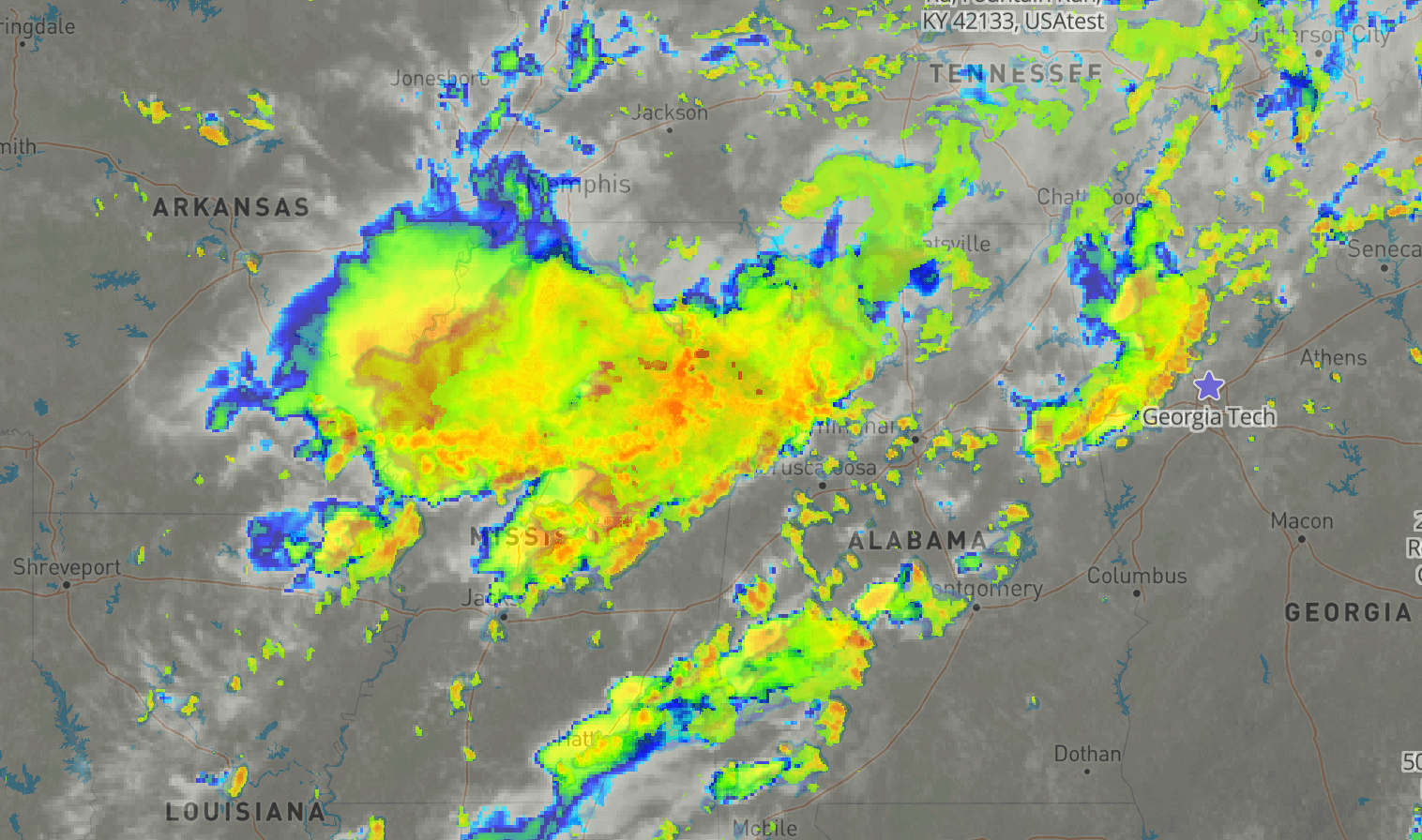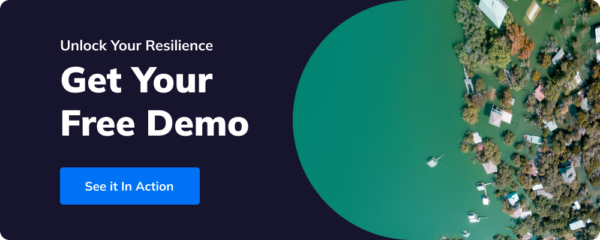TL;DR:
- Meteorologists predict an active and potentially severe 2024 tornado season in the U.S.
- Tornadoes often occur with little warning, causing significant damage to businesses and communities.
- Tornadoes can disrupt critical infrastructure, supply chains, and local economies.
- Businesses should prepare for tornado season by conducting risk assessments, developing emergency plans, training employees, fortifying facilities, and monitoring weather alerts.
- Tomorrow.io’s weather intelligence and resilience platform helps businesses make proactive decisions and react swiftly to tornado threats, ensuring business continuity.
Tornadoes often occur with very little warning.
Unlike hurricanes that can be tracked days or even weeks in advance, sometimes you only get a few hours or even minutes of warning when a tornado will strike.
This year, meteorologists predict an active storm season, potentially more severe than previous years. Climate patterns such as El Niño, play a significant role in shaping the severity of storm season, underlining the urgency of storm preparedness. Additionally, factors like soil moisture levels, jet stream patterns, and changes in our atmosphere all contribute to their development.
This year, the U.S. has already seen a significant number of reported storms, with Ohio reporting 63 storms by May 10, trailing behind Texas, 68, and Iowa, 64.
As we look ahead to the 2024 storm season, businesses and communities across tornado-prone regions have the power to take proactive measures. By doing so, they can significantly mitigate the potential impact of these natural disasters.
Even if your business isn’t directly affected, your customers might suffer if your employees or suppliers are in the tornado’s path. There might be shortages in raw supplies, your deliveries can’t get through, or your customers can’t order goods.
The increasingly unpredictable nature of severe weather events such as tornadoes means your business must be well prepared for all eventualities. But what is the impact of being on high alert all the time on business leaders, and how can weather intelligence ease the burden?
How Do Tornadoes Impact Businesses?
Tornados are violently rotating columns of air that extend from a thunderstorm to the ground. They are nature’s most violent storms with winds reaching over 300 mph (480 km/hr) in severe cases.
5/21/24 – The Greenfield, Iowa multivortex. I’ll never forget this day. As soon as this tornado planted I knew it was incredibly violent. pic.twitter.com/S1TrJrEjVy
— Lauren Baca 🌪️ (@laurenbacawx) June 7, 2024
Tornadoes typically have a small diameter, ranging from a few meters to 2 miles (2km) at their widest point. These storms are usually short-lived, some lasting only 15 minutes at a time.
Despite their size and short lifespan, the impact of tornadoes can’t be underplayed.
In 2023, the U.S. reported 1,423 tornadoes and 1,350 confirmed tornadoes. This number is above the 1991-2010 annual U.S. average of 1,251 tornadoes, revealing an uptick in high-impact weather.
As a result, we saw significant impact with storms across the United States last year
- March 31, 2023 Outbreak
- Over 160 tornadoes were reported that day, this was the most prolific tornado outbreak of 2023, with storms tearing across many southern and central states.
- An EF-3 tornado near Pulaski, Arkansas injured 54 people and led to one fatality, likely causing significant business damage and disruptions in that area.
- Another EF-3 tornado near Covington, Tennessee injured 28 people, killed 4, and undoubtedly impacted local businesses.
- In total, this outbreak led to over 20 fatalities and more than 200 injuries reported across the states
- April 1, 2023 Delaware
- A 700-yard-wide EF-3 tornado struck in Delaware, marking the widest tornado on record for the state
- Caused significant property damage, business disruptions, and economic impacts given its extreme width, 14-mile-long path, and strength
Tornadoes can have a profound and long-lasting impact on affected areas, disrupting various aspects of daily life and causing significant challenges for communities, businesses, and governments.
Last year, the NYT reported the March 31 outbreak, “…collapsed a theater in Illinois. Tossed cars in Little Rock, Ark. Flattened homes in Tennessee. And left thousands without power in New Jersey.”
When critical infrastructure is damaged, it can trigger a series of cascading effects that extend far beyond the initial destruction
Tornadoes can disrupt:
- Power supply: Damage to power lines and transformers can cause widespread outages, affecting homes, businesses, and essential services.
- Gas lines: Ruptured gas lines can lead to evacuations and potential fire hazards.
- Transportation: Debris from the tornado can block roads, prolonging closures and hindering public transit, which can further impact local businesses and residents’ ability to travel.
- Healthcare: Hospitals and medical facilities may face challenges in providing care due to power outages, damaged equipment, or limited access for staff and patients.
- Communication: Damage to cell towers and other communication infrastructure can disrupt phone and internet services, making it difficult for residents to stay informed and connected.
- Local economy: Business closures, reduced customer traffic, and supply chain disruptions can have a significant impact on the local economy, leading to financial hardship for many.
- Emergency services: First responders may face challenges in reaching affected areas due to debris and damaged roads, which can slow down rescue and recovery efforts.
And that’s only scratching the surface.
When tornadoes destroy buildings and infrastructure, businesses are unable to bring in supplies, staff appropriately, or sometimes even open.
The Importance of Storm Prep
While tornadoes can occur with little to no warning, meteorologists are often able to identify environments conducive to tornado formation hours or even days in advance.
However, pinpointing the exact timing and location of where a tornado will touch down remains extremely challenging due to their small scale and rapid development from thunderstorms.
Relying solely on historical data or general seasonal patterns from previous years provides limited information when it comes to predicting and preparing for storms in advance.
To properly prepare for tornado season threats, it’s crucial to monitor up-to-date forecasts, watches, and warnings from official sources that take into account the current local atmospheric conditions and short-term computer model guidance.
General weather information can provide context but cannot substitute real-time analysis and alerts from meteorologists closely tracking evolving severe weather.
Business continuity is key, but profitability and maintaining operations must be balanced with keeping workers safe.
From Storm Reactivity to Proactivity
What if you can access the necessary data but don’t see it fast enough to alert your team?
For example, do you know the difference between a tornado warning and a tornado watch?
A tornado watch means a tornado may develop, while a tornado warning means one is imminent.
These warnings are only issued an average of 13 minutes before the events when it’s too late to start preparations.
Businesses need to be able to act rapidly in pivoting in hazardous conditions to protect their assets and employees.
But how can they do that if they don’t have the alert sent out to the team immediately or if it comes from multiple sources that don’t line up to provide an overall picture?
Disaster preparedness starts long before severe weather strikes .
Businesses must invest in the infrastructure, risk assessments, matrices, and incident response plans to leverage an early warning system that will support their entire teams.
They also need to identify their tornado-related exposures so they can have the right insurance in place to recover quickly and avoid disastrous losses.
How to Prepare Your Business For Tornado Season
You can do many things to prepare your business for tornado season.
- First, conduct a risk assessment to understand your potential vulnerabilities.
- Develop a comprehensive emergency plan that outlines procedures for sheltering, evacuation routes, and communication protocols.
- Assign specific roles and responsibilities to employees and provide training on tornado safety.
- Ensure your facility is fortified against high winds, secure outdoor equipment, and trim trees that could become projectiles.
- Maintain an emergency supply kit with essentials like water, non-perishable food, and first-aid supplies.
- Finally, stay vigilant by monitoring weather alerts and planning to account for all personnel during and after a tornado strikes.
Ready.gov also has a list of recommendations, including preparing for a long-term stay at home or shelter in place by gathering emergency supplies, cleaning supplies, non-perishable foods, water, medical supplies, and medication.
How Can Weather Data Improve Tornado Forecasting?
You might already have that emergency preparedness plan, but how quickly can you implement it in response to the forecast?
Are you tuned into the actual weather data and insight that alert you of weather-related business disruptions?
Companies need the right data and insight to respond quickly and decisively when severe conditions materialize.
In other words, you need to put historical and real-time, hyper-local weather data in the context of your business:
- Shipping companies need to re-route shipments to avoid the worst of the storm
- Trucking operators need to staff more drivers to accommodate slower drive times, keep drivers safer on the road, and limit the risk of damaged goods.
- Port authorities need to reduce port closure time while balancing crew safety with profitability, as well as coordinating arrivals and departures to avoid damage to vessels.
- Insurance companies need insight into short- and long-term weather predictions to price coverage accurately.
- Utility and energy businesses need to reduce outage time by pre-positioning crews, where outages will have the largest financial impact.
- On-demand companies need to understand if orders spike even more during severe weather and how a spike in demand affects ETAs and drive times
Businesses are increasingly turning to weather intelligence for real-time risk assessments based on the weather.
Recent advancements in weather intelligence and resilience platforms from Tomrrow.io allow you to act faster to prepare for any weather event and ensure a rapid and complete rebound in the aftermath of a destructive weather event like a tornado.
The Power of Resilience Tools and Weather Intelligence
With weather intelligence-powered resilience platforms, you can understand how the weather will affect your specific business’ operations and what you need to do to mitigate any disruption.

With Tomorrow.io, businesses can make decisions in advance and in real-time. They can have emergency preparedness plans and early warning systems in place but also react swiftly to fast-moving events with automated alerts if conditions become dangerous.
Plus, with new updates to the Tomorrow.io Resilience Platform, businesses can ensure they have the right tools to prepare their business for tornado season.
Ready to prepare your business for tornado season?

















